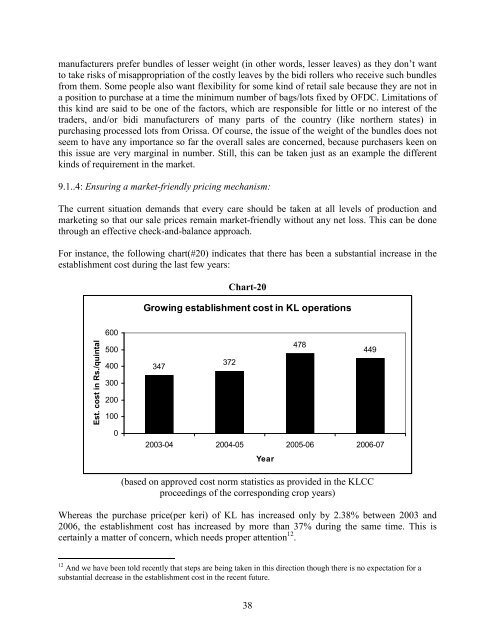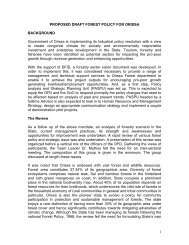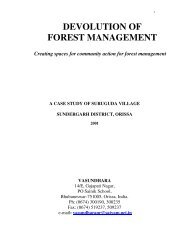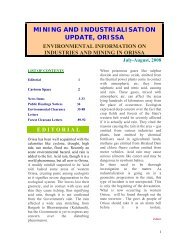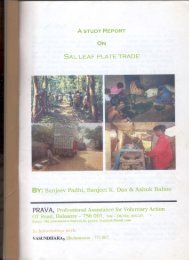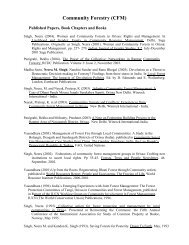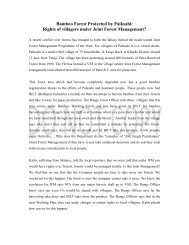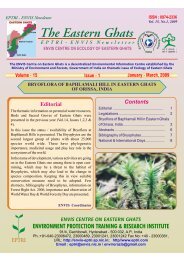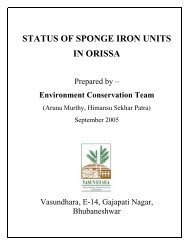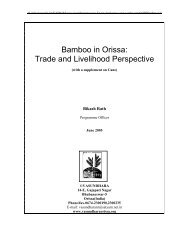The Kendu Leaf Trade: Problems & Prospects in Orissa - Vasundhara
The Kendu Leaf Trade: Problems & Prospects in Orissa - Vasundhara
The Kendu Leaf Trade: Problems & Prospects in Orissa - Vasundhara
Create successful ePaper yourself
Turn your PDF publications into a flip-book with our unique Google optimized e-Paper software.
manufacturers prefer bundles of lesser weight (<strong>in</strong> other words, lesser leaves) as they don’t want<br />
to take risks of misappropriation of the costly leaves by the bidi rollers who receive such bundles<br />
from them. Some people also want flexibility for some k<strong>in</strong>d of retail sale because they are not <strong>in</strong><br />
a position to purchase at a time the m<strong>in</strong>imum number of bags/lots fixed by OFDC. Limitations of<br />
this k<strong>in</strong>d are said to be one of the factors, which are responsible for little or no <strong>in</strong>terest of the<br />
traders, and/or bidi manufacturers of many parts of the country (like northern states) <strong>in</strong><br />
purchas<strong>in</strong>g processed lots from <strong>Orissa</strong>. Of course, the issue of the weight of the bundles does not<br />
seem to have any importance so far the overall sales are concerned, because purchasers keen on<br />
this issue are very marg<strong>in</strong>al <strong>in</strong> number. Still, this can be taken just as an example the different<br />
k<strong>in</strong>ds of requirement <strong>in</strong> the market.<br />
9.1..4: Ensur<strong>in</strong>g a market-friendly pric<strong>in</strong>g mechanism:<br />
<strong>The</strong> current situation demands that every care should be taken at all levels of production and<br />
market<strong>in</strong>g so that our sale prices rema<strong>in</strong> market-friendly without any net loss. This can be done<br />
through an effective check-and-balance approach.<br />
For <strong>in</strong>stance, the follow<strong>in</strong>g chart(#20) <strong>in</strong>dicates that there has been a substantial <strong>in</strong>crease <strong>in</strong> the<br />
establishment cost dur<strong>in</strong>g the last few years:<br />
Chart-20<br />
Grow<strong>in</strong>g establishment cost <strong>in</strong> KL operations<br />
Est. cost <strong>in</strong> Rs./qu<strong>in</strong>tal<br />
600<br />
500<br />
400<br />
300<br />
200<br />
100<br />
0<br />
478<br />
449<br />
347<br />
372<br />
2003-04 2004-05 2005-06 2006-07<br />
Year<br />
(based on approved cost norm statistics as provided <strong>in</strong> the KLCC<br />
proceed<strong>in</strong>gs of the correspond<strong>in</strong>g crop years)<br />
Whereas the purchase price(per keri) of KL has <strong>in</strong>creased only by 2.38% between 2003 and<br />
2006, the establishment cost has <strong>in</strong>creased by more than 37% dur<strong>in</strong>g the same time. This is<br />
certa<strong>in</strong>ly a matter of concern, which needs proper attention 12 .<br />
12 And we have been told recently that steps are be<strong>in</strong>g taken <strong>in</strong> this direction though there is no expectation for a<br />
substantial decrease <strong>in</strong> the establishment cost <strong>in</strong> the recent future.<br />
38


